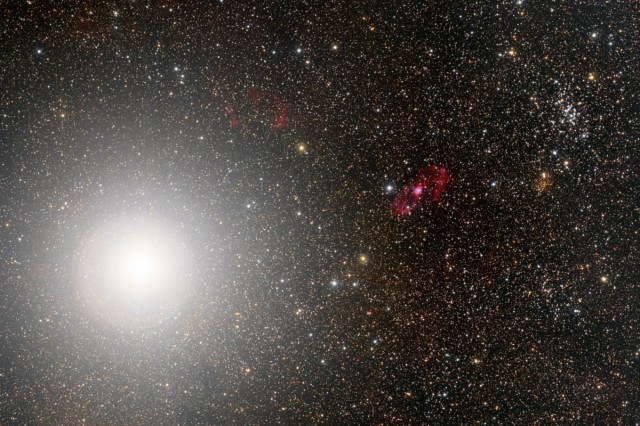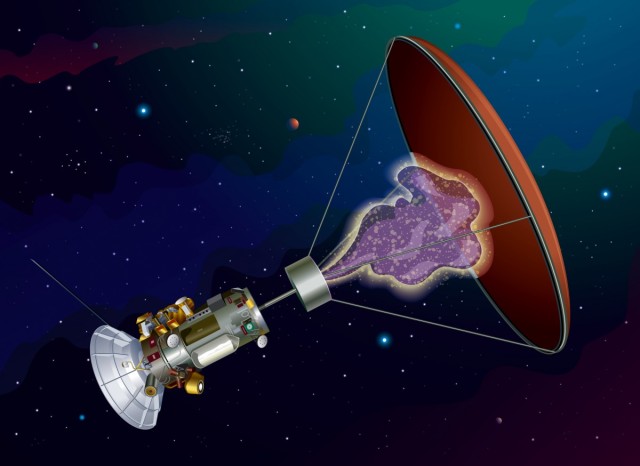Dreams of antimatter space propulsion are closer to reality than most rocket scientists could ever imagine, says former Fermilab physicist Gerald Jackson. In fact, if money were no object, he says an antimatter-driven spacecraft prototype could be tested within a decade. To that end, next month, Jackson and his Chicago-based Hbar Technologies firm are launching a $200,000 Kickstarter campaign to crowdfund the next phase of its antimatter propulsion research.
With propulsion velocities of some 40% of the speed of light, such technology could eventually cut travel times to the nearby Alpha Centauri star system to less than a decade. And more immediately, it would allow NASA to send a New Horizons-type probe to our outer solar system in a year or less.
If you send a probe into interstellar space, you don’t want the propulsion system to weigh a million times more than the payload itself, Jackson, President of Hbar Technologies, told me.
“So, my Hbar partner, physicist Steven Howe, and I came up with a very light propulsion system whose mass was comparative to the payload — an antimatter sail,” said Jackson. “Funding dried up, so next month we’re going to try and restart this work.”
One main challenge for such rockets would be simply finding a sufficient supply of antimatter fuel. In nature, the center of our own Milky Way galaxy is aglow in the x-ray emission of antimatter annihilation, which is almost certainly associated with a jet of streaming high-energy particles emanating from our galaxy’s central supermassive black hole. On Earth, by contrast, most antimatter has to be generated in particle physics accelerators at laboratories like Fermilab or CERN.
But all total, the now defunct Tevatron accelerator at Fermilab made much less than one gram of antimatter; most of which was held in storage rings for a day or so at most.
Antimatter is just like normal matter, but all the particles have the opposite charge, James Annis, a physicist at Fermilab’s Center for Particle Astrophysics, told me. That means an antimatter electron has the opposite electric charge of a normal matter electron and also the ability to annihilate if it ‘finds’ its own partner particle.
Even so, Annis says normally the idea for anti-matter propulsion has been to take as much of that energy as possible and use it to heat hydrogen to high temperatures which is then blown out the back of a rocket.
“The problem with working with antimatter is that one has to keep it from touching matter, which is surprisingly hard to do,” said Annis. “In ‘Star Trek,’ they have solved the containment [problem] somehow and are able to store lots of antimatter.”
However, Jackson and Howe think that, on paper at least, they have solved the containment issue and hope to use crowdfunding to hone their earlier antimatter designs for a robotic interstellar probe.
“Crowdfunding may be a good way to show interest in the project when it comes time to find bigger investors or governmental support,” said Jackson. “We will then need funding on the order of $100 million to actually build small prototype propulsion and power systems.”
We use the antiproton as a spark plug to induce fission, explains Jackson. And from this fission, he says, emerges what nuclear physicists term lighter “fission daughter” byproducts.

The glare of Alpha Centauri, one of the brightest stars in planet Earth’s night sky, floods the left side of this southern skyscape. Credit: Marco Lorenzi (Glittering Lights).
Each such antimatter annihilation releases two billion electron volts (2 GeV) of energy. Thus, an antimatter rocket, which would only be launched outside of Earth’s atmosphere, could provide a lot more thrust than a chemical or even nuclear rocket and use tens of thousands of times less fuel , says Jackson.
As envisioned in Jackson and Howe’s original design, a small antimatter robotic probe would consist of four basic components: a depleted uranium-coated carbon sail; a solid antihydrogen storage unit; an antiproton-driven electrical power supply, and a small payload instrument package at the back of the spacecraft.
Upon being struck by antihydrogen protons, a portion of the depleted uranium situated on coated foil inside the spacecraft is caused to fission. This creates two “fission daughter” byproducts which typically are emitted back-to-back with equal momentum. While the two daughters may not be exactly alike atomically, in order to adhere to known laws of physics, their momentum inherently must be equal, says Jackson. One fission daughter heads into the direction of the spacecraft’s uranium-coated carbon sail and is decelerated and absorbed; imparting its momentum into the sail. The other escapes into space in the form of conventional propellant exhaust. It’s the opposing forces of their powerful kinetic energies that enable the spacecraft to reach such high speeds.
Jackson would like to take a portion of the initial $200,000 he and Stowe are seeking to build a device to measure such thrust.
The biggest tech challenge says Jackson is the getting money to produce enough antiprotons to do the actual tests. Such antiprotons are usually generated in particle accelerators by aiming fast moving hydrogen atoms into a nickel target.
“For every 100 protons that hit the target, there can be yields of up to one anti-proton,” said Jackson.
When could an antimatter propulsion prototype be tested in space?
If the money were there, we could do it in ten years, says Jackson, noting that it would take a $100 million to design an Earth-based technology test. “But you’re talking billions to send spacecraft out to real destinations,” said Jackson.
But he says if the will is there, spacecraft capable of cruising along at 40% of lightspeed should be achievable within the next two to three decades.
Top Photo: Artist’s concept of Hbar Technologies’ antimatter probe – Steven Howe/Hbar Technologies, LLC
Source: Forbes

